Left-handed individuals often navigate a world designed for the right-handed majority, and guitarists are no exception. While left-handedness affects around 10% of the population, the availability of Left-handed Guitars has historically been disproportionately low. Many iconic musicians, facing this scarcity, adapted in various ways. Jimi Hendrix famously played a flipped-over right-handed Stratocaster, while others like Robert Fripp learned to play right-handed. Albert King even played his guitar upside down, right-handed and all! Today, options for left-handed guitar players are improving, but the quest for the perfect instrument can still present unique challenges.
Imagine finding an exceptional acoustic guitar, only to discover it’s right-handed. When a truly special guitar resonates with you, handedness shouldn’t be a barrier. Fortunately, converting a right-handed acoustic guitar to left-handed guitar is a viable solution. This process, however, goes beyond simply restringing; it requires precision and expertise. This article details a recent left-handed guitar conversion project, offering insights into the necessary steps.
The project involved transforming a high-quality Martin guitar into a left-handed guitar. Despite being a right-handed model, its exceptional sound captivated its left-handed owner. The crucial element in converting an acoustic guitar lies in addressing the bridge saddle. Acoustic saddles are intentionally angled to compensate for the varying gauges of guitar strings, ensuring accurate intonation. Simply reversing the strings on a right-handed saddle would lead to sharp notes on the lower strings and flat notes on the higher strings.
The initial right-handed bridge saddle is shown below:
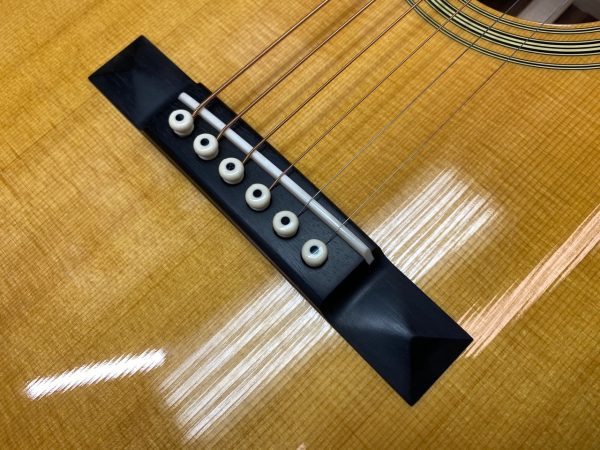 Original right-handed acoustic guitar bridge saddle
Original right-handed acoustic guitar bridge saddle
To prepare for installing a new left-handed guitar saddle, the first step was to fill the existing saddle slot. A piece of ebony, carefully chosen to match the bridge’s color, was cut to fit the slot. This ebony piece was then glued into place, and meticulously carved and sanded to seamlessly integrate with the bridge.
 Ebony being glued into the saddle slot of the acoustic guitar bridge
Ebony being glued into the saddle slot of the acoustic guitar bridge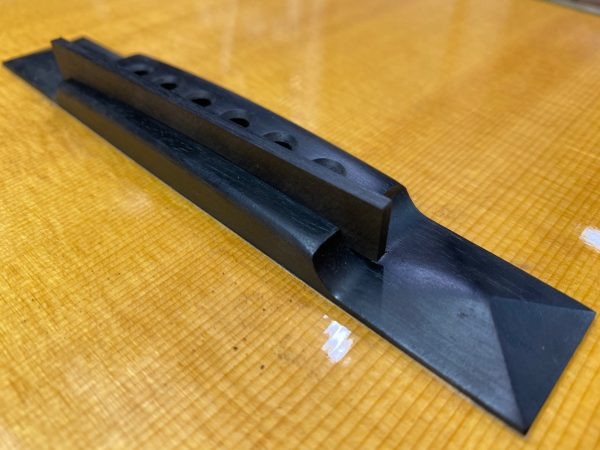 Ebony filler piece after being carved and sanded to match the guitar bridge
Ebony filler piece after being carved and sanded to match the guitar bridge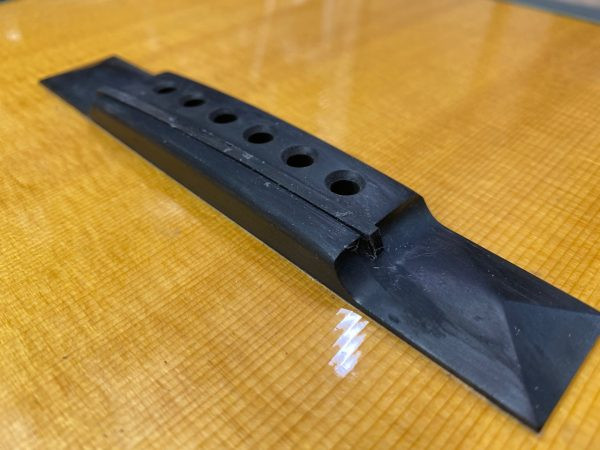 Close up of the filled saddle slot on the acoustic guitar bridge
Close up of the filled saddle slot on the acoustic guitar bridge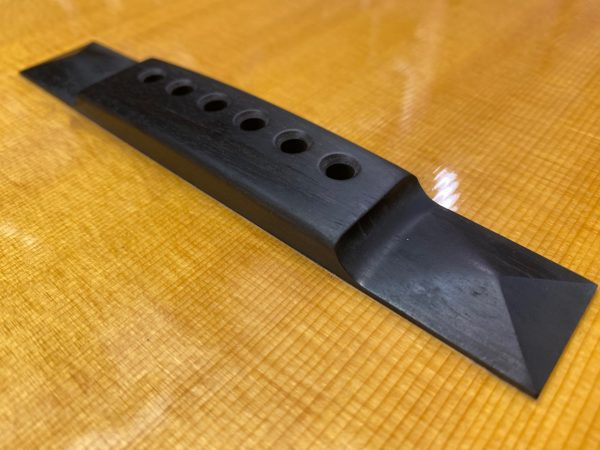 Smoothly filled and sanded saddle slot ready for new cut
Smoothly filled and sanded saddle slot ready for new cut
The next, more intricate stage involved cutting a new saddle slot in the correct position and angle on the bridge. Precision is paramount here to guarantee accurate intonation and playability. While traditional methods involve routing jigs and manual calculations, advancements in technology offer enhanced precision. In this project, a PLEK machine was utilized to cut the new slot with exceptional accuracy. After careful measurements, the PLEK machine was programmed to cut the slot precisely for a left-handed guitar setup.
The PLEK machine efficiently executed this critical task, resulting in a perfectly positioned saddle slot. The modification is so seamless that it’s almost imperceptible that the bridge was originally designed for a right-handed guitar.
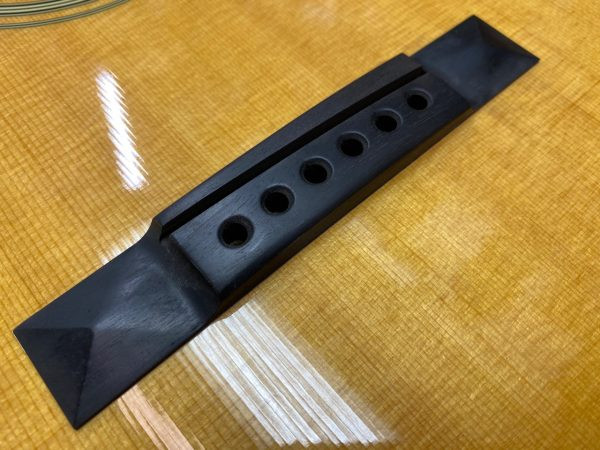 New left-handed saddle slot precisely cut by PLEK machine
New left-handed saddle slot precisely cut by PLEK machine
While advanced tools like the PLEK machine streamline certain processes, traditional skills remain indispensable in guitar servicing. Creating a new nut and saddle for the left-handed guitar conversion requires a more hands-on approach. Bone is a preferred material for nuts and saddles, and their creation is largely a manual craft, blending technical skill with artistry. Transforming raw pieces of bone into precisely shaped and functional components is a rewarding aspect of guitar modification.
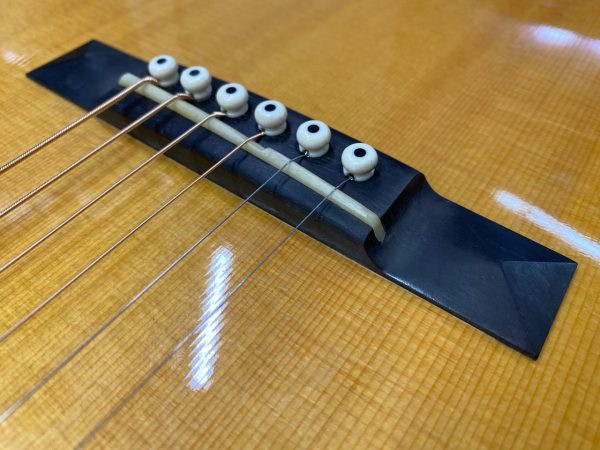 Bone blanks prepared to be shaped into a new nut and saddle
Bone blanks prepared to be shaped into a new nut and saddle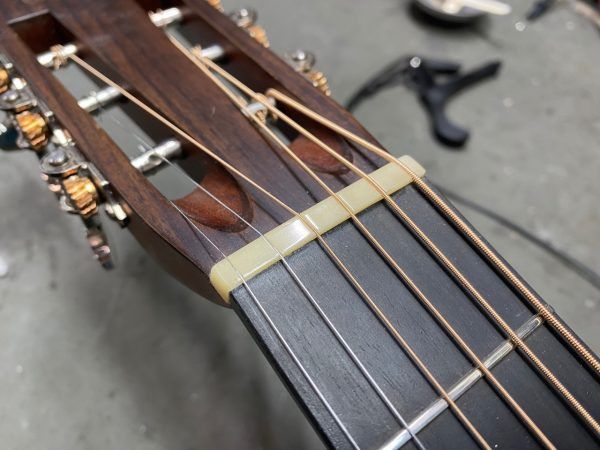 Hand-shaped bone nut and saddle for the left-handed guitar
Hand-shaped bone nut and saddle for the left-handed guitar
To complete the left-handed guitar conversion, side dots were added to the opposite side of the neck. These dots serve as visual markers for fret positions, crucial for navigation, especially for a left-handed player adapting to a converted instrument.
With all modifications complete, the newly converted left-handed guitar was finalized with a fret leveling using the PLEK machine and a comprehensive setup. For a right-handed guitarist, attempting to play a left-handed guitar can highlight the challenges faced by left-handed players in a right-handed world. Converting a right-handed acoustic guitar opens up a world of possibilities for left-handed guitar players, ensuring that handedness doesn’t limit their musical choices. With careful modifications, a right-handed acoustic can be expertly transformed into a left-handed guitar, offering lefties access to a wider range of instruments.
